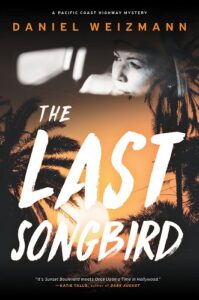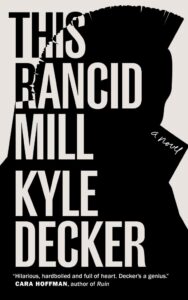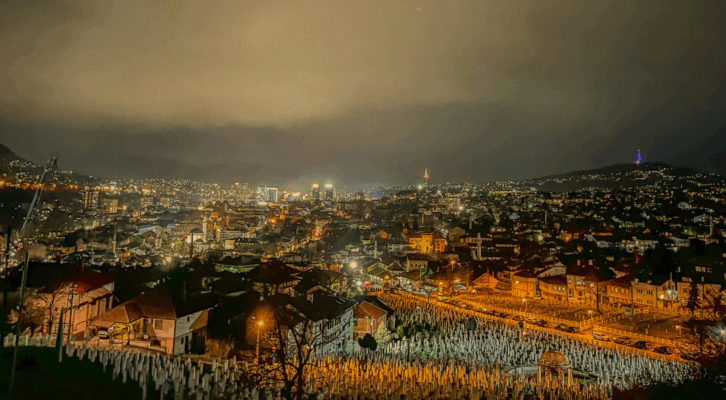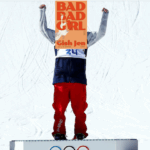Kyle Decker is a musician and teacher, whose years playing in punk bands inform his new book, This Rancid Mill. Like the genre that inspired it, Decker’s This Rancid Mill embodies a punk ethos of DIY, not giving a shit, social critique, and a heavy dose of sardonic humor. Daniel Weizmann has written about punk culture and music for fanzines and newspapers, and now brings his considerable knowledge of the music work to his new book,The Last Songbird, about a failed musician turned cabbie who is searching for answers after his favorite client, a faded folk musician, disappears. We asked these authors to talk about music and mystery, which turned into of the most intriguing conversations we’ve ever put together. Enjoy!
Kyle’s questions for Daniel:
KD: You’ve got a helluva resume overall. Music journalist, songwriter, spoken word artist, ghostwriter, short story writer, and now a novelist. Do you consider yourself one of these “more” than the others? Or do they all overlap and inform each other?
DW: I guess I followed my confusions wherever they led! Sometimes a rant, sometimes a poem or a memory. But all along, I carried around the secret dream of writing a detective mystery like a lucky penny. I was a SPERDVAC member in grade school, collecting old radio shows, obsessed with Vincent Price as The Saint, the Raymond Chandler and Ross Macdonald paperbacks, Columbo, the Rockford Files, Darren McGavin’s The Outsider—all those detectives reminded me in some way of my dad who I adored.
…but you know, also, I came of age in punk, and punk was always noir! Always a branch off the tree of urban mystery. That’s one of the things I love about your novel—it joins the electricity from these natural twins. My first fanzine was called Rag in Chains, first poetry chapbook was Happy Go Deadly. The language of punk lyrics—the direct and fleet-footed truth–owes as much to the detective paperback as it does to rock and roll. “She wasn’t what you’d call living, really—but she was still awake.”
Of course, my first attempts to write a full-length mystery at 14, 15, were just terrible! All about a cliché kind of private eye with the fan on his desk blowing cigarette smoke out the window into the hot summer day. I tried again at 23, 26, 31, 38, 42. I kept worrying about the plot when the real answer was in the character of the detective himself.
KD: The crime genre is full of various tropes. Were there any you wanted to be sure to include, omit, or outright subvert?
DW: Many detectives, including some that are dear to me, pride themselves on their power of deductive reasoning and sharp use of scientific method and when they nail the bad guy, order is restored. Fair enough.
But I couldn’t get cooking until I discovered a detective who is somehow more porous, more vulnerable and confused than all that—Zantz is a shlepper, a loser, near bankrupt, and a wimp. And even more than that, he’s what you call a luftmenschen in Yiddish, his head is in the clouds, swimming in song lyrics. Or, as he himself puts it, “I’m about as hardboiled as scrambled eggs.” He’s the last person on earth you’d expect could solve a crime—except that his heart gets snagged on things, he feels for the people around him. And this quality helps him come to understand that guilt is complex and communal.
KD: I’m a high-school teacher by day, so I did my homework. I saw you were the “as-told-to” for Dee Dee Ramone’s Lobotomy, which I used in my research, making this conversation a full circle moment for me. Your bio also made mention you’ve performed spoken word alongside some big names and penned some lyrics for others. What have been some of your takeaways from all this proximity to celebrities? And in what ways did that inform themes in The Last Songbird?
DW: When you grow up in Hollywood, the crazy intersection of celebrity and reality is always right there in front of you. I mean, I met Groucho when I was 9 or 10. He was older, wearing a beret and walking down the street with his two beautiful young nurses. Then a year later I wrote Gene Kelly a fan letter and he wrote me back—he signed his name with a little four-leaf clover growing out of the y. Later I did interview some pretty famous people but you could always see a human being there if you looked close enough—it’s almost like, inside every celebrity is an actual human dying to come out!
You couldn’t stay starstruck around DeeDee Ramone though, he was too funny. He said, “Yeah–you know, I wrote ‘I Don’t Wanna Grow Up’ and ‘I Don’t Wanna Walk Around With You’…but when I wrote ‘I Wanna Sniff Some Glue’ that was, like, my first positive song.”
KD: A definite common thread for our respective work is the central role that music plays. Are there any artists or genres you tried to evoke with The Last Songbird? What were you listening to as you were writing it?
DW: When I’m drafting a scene, I listen to exotica–Les Baxter, Martin Denny, Alex Keack’s “Surfer’s Paradise.” The mystery mood helps me dream. .
Then, I also use songs to “seal the deal.” What I mean is, a chapter is never finished until I can identify the exact right song and lyric line to match it. It’ll sometimes take a dozen misfires before finding the song that absolutely nails the chapter’s true essence. Then, when the draft is ready, the whole story becomes a mixtape. This is my Spotify chapter-by-chapter playlist for The Last Songbird.
KD: Your narrator, Adam Zantz, is a songwriter and we get some taste of his lyrics throughout the book. What do you imagine his songs sound like? Do you hear the fictional songs in your head? Who do you see his influences as being? Or are you leaving it up to the reader?
DW: What a great question! The thing about Zantz is that he’s just not very good, and he’s trying to write hit records! So I hear two things in my head–first Zantz singing in his car or playing clumsily along with the Casio in his pad…and then his fantasy about how it would all sound with full orchestration and top-flight studio musicians–produced by Pharrel or Antonoff or somebody.
KD: Punk is clearly a prominent portion of your bio. Are there aspects that you’ve carried with you? Or, perhaps, some elements of it you’ve “outgrown”?
DW: Punk was the greatest education money can’t buy, because it came with a mandate to see the world through your own two eyes. Of course, I don’t listen to punk rock music all day or every day anymore, but that mandate, to make an honest account of first-hand impressions…I try not to outgrow it.
KD: As someone who covered punk in its heyday, what are your thoughts on the state of the genre today?
DW: I just don’t know anything about it. Is it good? More importantly—is it freeing the kids, helping them survive? Can punk handle the 21st century?
KD: The Last Songbird has the subheading “A Pacific Coast Mystery.” Is it the first in a series? I get the feeling we haven’t seen the last of Adam Zantz.
DW: Yes! Zantz is cruising PCH in several marked up drafts at the moment! Let’s hope he keeps his eyes on the road.
Daniel’s questions for Kyle:
DW: Your mystery takes place in punk rock Los Angeles of the early ’80s and the attention to detail is downright astonishing—everything from Oki Dogs to X-Head’s stepdad to Eddie Nash and single-fridge HB garages and beyond. Many non-fiction titles I’ve read about that era have been far less accurate and I was happy to be unable to turn up a single boo-boo! But what drew you to that time and place?
KD: Well, I’m glad I was able to capture it so accurately. That was something I took great care to do. When I first came up with the idea for Alex Damage I did consider other locations. New York, DC, or Chicago. In doing my research, though, a lot more had been documented about LA. Overall, I think that’s where a lot of people’s minds go when they think of American punk, too. And while I wanted to subvert certain expectations in terms of punk and noir, it’s still important to conform to expectations to a degree. Otherwise, there’s nothing to subvert.
Also, I’m fascinated by cultural shifts. And the big shift occurring within LA’s punk scene at the time, with it starting to become more violent and more macho in 1980/81, is just ripe for conflict.
DW: I was also impressed by the way you caught the unhinged energy of the people of those times—cops, parents, crooks, politicians, porn stars, and punks—everyone’s winging it, just as I remembered it. How can something like that be researched? How did you do your research? What are the biggest challenges of trying to write historical fiction for recent history? Were there any big surprises along the way?
KD: I think a lot of that is as true in the 2020s as it was in the 1980s. Everyone really still is winging it most of the time. Which, honestly, I find a great deal of comfort in the idea that we’re all lost. It’s not inadequacy. It’s just universal.
As far as how I do my research, my mother is a retired special education teacher. And she spent a large part of her career teaching high-school history. So, she was always on me about properly doing my own history papers. Now I’m the one teaching students how to do research. It’s really about just having a variety of sources. And since this was only about 40 years ago, a lot of those sources are primary sources. For example, Henry Rollins’s tour diary, Get in the Van. Or Penelope Spheeris’s film The Decline of Western Civilization. You can find published editions of ‘zines and some are archived online. As I wrote I also had Google maps open, so I could figure out where places were in relation to each other. Before I referenced places, I made sure I could confirm when it was built, or if it was still open.
The biggest challenge of writing recent history is people who lived it are still alive to call you out if you donk it up. The biggest surprise was the overlaps in stories from various sources. One example is a story that comes up in Lexicon Devil, the oral history of Germs, and My Damage, Keith Morris’s memoir. Apparently, sometime in 1980, punks pushed a flaming dumpster down a hill on San Vicente in LA. In Lexicon Devil it’s mentioned that a lot of people thought Darby Crash did it. In My Damage, Morris mentions having done it.
DW: I love the way the book draws lines between personal, local, and global tumult. It led me to your bio which says that you spent much of the last decade in South Korea. Does that mean you wrote this book there?! What goes on in South Korea that might inspire a SoCal punk rock mystery that ties the mob to Reagan’s government and the Guardia Nacional of El Salvador?
KD: I wrote most of it there. A lot was going on that inspired it. Of course, North Korea, with the threat of nuclear war and the controversies about refugees, has parallels with Reagan-era cold war politics. All the “Me too” news, which informed a lot of the themes in the book, reached worldwide and similar reckonings were happening in Korea as well. There were a handful of Korean nationalist punk and metal bands. Ironically, one of those guys owned and operated a Japanese restaurant.
Plus, in 2016/2017, far-right former president Park Guen-Hye was ousted from office, arrested, and convicted for corruption. Which, holy crap, is an amazing story. Seriously, look it up. The story goes back to the 70s when her father was a dictator and involves assassinations, a Shamanistic cult, a college equestrian club, a gigolo, cheap suits, money laundering, Samsung, a computer tablet, and a secret inner circle called “the Eight Fairies.” People showed up by the millions every weekend in every major city for over a month. Just candle-lit vigils with live music. And, outside the inevitable scuffles that happen when massive amounts of people flood the streets, they were peaceful. And they worked. It was inspiring to see. My visa status didn’t allow for direct involvement, but I was at plenty of shows where that was a talking point for bands. There’s definitely a book I will write loosely based on my time there.
DW: Alex Damage is an unforgettable private eye, not just because he’s a freewheeling Mohican punker but because he’s a great humorist! “There is a long list of things you do not want to be doing when the pigs walk in on you…near the top of that list is standing over a dead body with a bag full of heroin.” I also love that punks turn to him because they know they can’t go to the cops. How did you come to *know* this protagonist? Did you have any models or heroes? Will we hear more from Alex in future books?
KD: “Of course, I know him. He’s me.” Alex Damage is an easy character to write for because he’s basically an alternate-reality version of myself. His sense of humor and hyperbolic turns of phrase are very much like my own. Hell, his tendency to use “hell” as a transitional word is a vocal tick we share. My mom read it and said every time something bad happened to Alex, it felt like something bad was happening to me. She meant it as a compliment.
Actually, This Rancid Mill is the third appearance of Alex Damage in print. He appeared in a short story called “The Final Nail” in Mystery Magazine in March 2021, although that was written and is set after TRM. And he was in a flash-fiction piece called “Moral Threat” in Mystery Tribune back in June 2022.
There’s definitely more Alex Damage in the future. Even got a draft of a sequel. But I still got to give it the once over twice.
DW: Tell me about how you came to choose the brilliant title of this book—one of Darby’s strangest, most fearsome images. What does it mean to you?
KD: “Lexicon Devil” is fascinating lyrically. For me, the song is an anti-establishment call to arms. The stand-out line is definitely “We’re gonna wreak havoc on this rancid mill.” Mills are machines of production, but mills are machines that produce something by grinding or breaking down something else. And there really is no better metaphor for capitalism than that, is there? Ah, but this mill’s gone rancid. It’s spoiled. Falling apart. Creating an opportunity for those being ground down by it to wreak havoc on it.
Alex meets characters that are either microcosms of institutions both mainstream and countercultural that are turning or have turned rancid, or the people who are taking the brunt of the collapse. The latter of which, unfortunately, is often women.
Also, the line right after that is “I’m searching for something even if I’m killed.” Which is the exact situation Alex Damage finds himself in.
DW: One of my favorite parts of This Rancid Mill are the original punk names—Tom Numb, Rapunzel, Double Dare, Rad… Where did you draw your inspiration for them? Do you have some faves from real life?
KD: The names were a blast to come up with. Alex Damage comments at one point that nicknames aren’t really up to you. Which was why I never really had a punk name. No one “gave me one.” Although, I don’t know how true that really is. Darby Crash gave himself that name but only after calling himself Bobby Pyn for a spell. So, I guess not only can you give yourself one, but it can also be fluid.
A few names are multi-layered “puns.” Take Tom Numb, for example. His name is Tom. A popular character with that name is Tom Thumb, which rhymes with “numb”, which sounds tougher. Dumb stuff like that. The kind of thing a fifteen-year-old Huntington Beach thug would think sounds clever.
Rapunzel, though, I can’t fully claim. One of my friends from an ex-pat writer’s workshop, an Aussie named Doug, said: “You should have a skinhead character named Rapunzel.” And I agreed. Wholeheartedly. So, credit where credit is due: Thanks, Doug!
Real-life favorites? Toss up between John Doe and Lux Interior. Joey Shithead’s also pretty good. The question is whether it’s still funny if it sticks with you in your 60s. Or if it’s even funnier.
DW: What are your fave punk records? Which inspired the book most?
KD: The song that put the idea of a punk rock PI into my head was “Private Eye” from the Chicago band Alkaline Trio. I’d had that swimming in my cerebral fluid since I first heard the song back in high school. It just took me over a decade to do anything with it.
Favorite punk records, though? I’ll do a top-six. Three recent from wherever and three of the era from the west coast. No particular order. And I reserve the right to give a different answer tomorrow.
Recent/Wherever:
1. Comfort to Me by Amyl and The Sniffers. 2021. Melbourne, Australia
- Modern Medicine by School Drugs. 2019. New Jersey, New Jersey.
- 1집 by Slant. 2019. Seoul, South Korea.
Late 70’s/Early 80s West Coast
- The First 4 Years by Black Flag. 1978-1981 compilation. Los Angeles, California.
- Fresh Fruit for Rotting Vegetables by Dead Kennedys. 1979. San Francisco, California.
- Is This Real? The Wipers. 1979. Portland, Oregon.
DW: Bad Chemicals are prominently featured in the novel and it seems you have discovered their rare tapes. (badchemicalsband.bandcamp.com) Where is the band today? Where can readers get in the pit and do the HB Strut to Bad Chemicals?
KD: My brother’s friend Barrett co-owns Treehouse Records, a recording studio and practice space on Chicago’s northwest side. These tapes were found behind a shelf during renovations. No idea how they got there. Probably got mixed in with some second-hand equipment. There were a few clearly fake names on some worn-out masking tape. No number. Something that looked like an address was either illegible or illegitimate. “Bad Chemicals-1981” was the only fully readable bit. The tapes themselves were rough and poorly preserved, but you could tell it was good stuff. So we got some musicians together: My brother, Kevin, on bass, Barrett on guitar, and my brother’s friend Anthony on drums, with me doing vocals, and we reworked the album so these songs could exist in some form.
Kevin moved abroad, but Barrett, Anthony, and I played Liar’s Club in Chicago before they had to shift their attention back to their main projects. Although, if this publishes before April 29th and you’re in Chicago that day, a new Bad Chemicals lineup will be playing Live Wire Lounge (3394 N Milwaukee Ave. Chicago, IL) for the This Rancid Mill release event starting around 7pm. My brother is flying out to lay down the low end for that show.
DW: I’ve often wondered about that strange and fearsome word hardcore—hardcore punk, hardcore pornography, hardcore violence….it all seemed to bubble up together circa ‘79, ‘80, ‘81 and your novel does a great job shining a light on that crazy intersection of forces. Why do you think it all blossomed at once? Was there a “hardcore” source?
KD: I think it extends from the whole 1970s “Me Generation” thing. The post ‘Nam-era seemed to have more people focusing on the idea of “self.” Which, okay, cool. You do you, right? When people started really focusing on themselves and their interests, interests overall got more niche and thus had larger extremes. Whether it was in music or in porn or in whatever. Not everything needed to have as much broad mainstream appeal. On the plus side, this really gave birth to the gonzo DIY art and music scenes. Of course, self-focus, when taken too far, leads to being selfish, which can lead to violence. “It’s my right to have it if I have the will to take it.” Not that that was new in 1979 AD or even BC. But niches can definitely lead to tribalism and labeling people as “the other.” Which leads to fear, which leads to violence, which leads to more fear, and so on and so on…
***
The Last Songbird, by Daniel Weizmann, will be published on May 23 by Melville House.
This Rancid Mill, by Kyle Decker, is now available from PM Press.



















